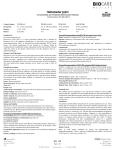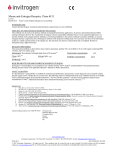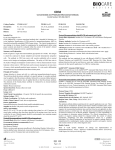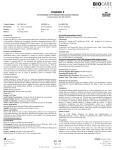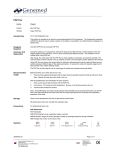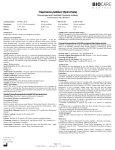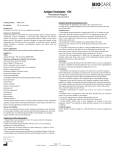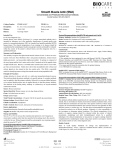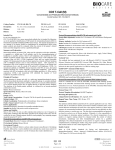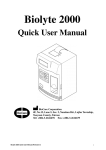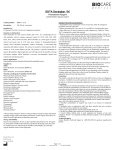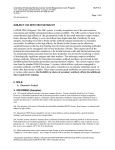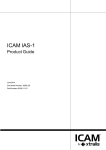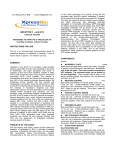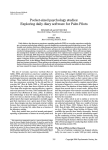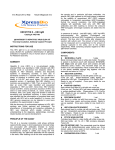Transcript
DAB Chromogen Kit DAB Chromogen and Buffer for the ONCORE Automated Slide Stainer ISO 9001&13485 CERTIFIED Control Number: 901-6011K-100214 Catalog Number: ORI6011K T90, T180 Description: 90 tests, 180 tests Intended Use: For In Vitro Diagnostic Use DAB Chromogen Kit consists of two solutions for the staining of formalin-fixed, paraffin-embedded (FFPE) tissues, as part of an immunohistochemistry (IHC) procedure using a horseradish peroxidase (HRP) detection system, on Biocare Medical’s ONCORE Automated Slide Stainer. The clinical interpretation of any staining or its absence should be complemented by morphological studies and proper controls and should be evaluated within the context of the patient’s clinical history and other diagnostic tests by a qualified pathologist. Summary & Explanation: Immunohistochemistry (IHC) permits the visual identification of specific protein antigens in tissues for diagnostic purposes. Following application of the primary antibody, the presence of a target antigen is visualized by the sequential application of an enzyme-antibody conjugate that binds the primary antibody, and a chromogen reagent, to produce a colored reaction product that is visible by light microscopy. 3,3’-Diaminobenzidine (DAB) is a widely used chromogen for immunohistochemical staining with horseradish peroxidase (HRP) detection systems. In the presence of peroxidase enzyme, DAB produces a brown precipitate that is insoluble in alcohol and xylene. DAB Chromogen Kit contains two solutions: DAB chromogen and the corresponding buffer. It is intended for use with an HRP detection system in an IHC staining procedure on the ONCORE Automated Slide Stainer. Known Applications: Immunohistochemistry (FFPE tissues) Reagents Provided: DAB Chromogen Kit is comprised of two solutions, DAB Chromogen and DAB Buffer, intended to be mixed prior to use and loaded onto the ONCORE Automated Slide Stainer: ORI6011K T90: DAB Chromogen (ORI6009 T90) 0.75 mL DAB Buffer (ORI6010 T18) 18 tests, 5 vials x 6 mL ORI6011K T180: DAB Chromogen (ORI6009 T180) 1.2 mL DAB Buffer (ORI6010 T36) 36 tests, 5 vials x 10 mL Reconstitution, Dilution and Mixing: DAB Chromogen and DAB Buffer should be mixed as indicated in the Instructions for Use, prior to each staining run. Materials and Reagents Required But Not Provided: Reagents and materials, such as primary antibodies, detection kits, chromogens and ancillary reagents are not provided. Refer to the ONCORE Automated Staining System User Manual for a complete list of materials and reagents required. Storage and Stability: Store at 2ºC to 8ºC. Do not use after expiration date printed on vial. DAB Chromogen may become pink to brown in color over time. This change in color is expected and does not affect staining performance. Avoid exposure to direct sunlight. Instructions for Use: Refer to the appropriate antibody data sheet for the recommended staining protocol. Refer to the ONCORE Automated Staining System User Manual for detailed instructions on instrument operation and additional protocol options. ORI6011K T90 (up to 18 Tests per run) 1. Add 3 drops of DAB Chromogen (ORI6009 T90) to one 6mL vial of DAB Buffer (ORI6010 T18). 2. Cap the vial and invert several times to fully mix components. 3. Apply the enclosed overlabel for the mixed solution, if desired. 4. Uncap the vial and place in the ONCORE Automated Slide Stainer reagent rack. 5. At the conclusion of the staining run, dispose of the reagent vial and any remaining solution in an appropriate waste container. Instructions for Use Cont'd: ORI6011K T180 (up to 36 Tests per run) 1. Add 5 drops of DAB Chromogen (ORI6009 T180) to one 10mL vial of DAB Buffer (ORI6010 T36). 2. Cap the vial and invert several times to fully mix components. 3. Apply the enclosed overlabel for the mixed solution, if desired. 4. Uncap the vial and place in the ONCORE Automated Slide Stainer reagent rack. 5. At the conclusion of the staining run, dispose of the reagent vial and any remaining solution in an appropriate waste container. Limitations: These reagents have been optimized for use with ONCORE antibodies, detections and ancillary reagents. The protocols for a specific application can vary. These include, but are not limited to fixation, heat-retrieval method, incubation times, and tissue section thickness. Third party primary antibodies may be used on the ONCORE; however, appropriate antibody concentration may depend upon multiple factors and must be empirically determined by the user. Ultimately, it is the responsibility of the investigator to determine optimal conditions. The clinical interpretation of any positive or negative staining should be evaluated within the context of clinical presentation, morphology and other histopathological criteria by a qualified pathologist. The clinical interpretation of any positive or negative staining should be complemented by morphological studies using proper positive and negative internal and external controls as well as other diagnostic tests. Quality Control: Refer to CLSI Quality Standards for Design and Implementation of Immunohistochemistry Assays; Approved Guideline-Second edition (I/LA28-A2) CLSI Wayne, PA USA (www.clsi.org). 2011 Precautions: 1. This product is intended for in vitro diagnostic (IVD) use. 2. DAB Chromogen is a suspected carcinogen. DAB Chromogen may be harmful or cause irritation if exposed to skin or eyes. Avoid contact with reagents and wear disposable gloves when handling reagents. 3. Specimens, before and after fixation, and all materials exposed to them should be handled as if capable of transmitting infection and disposed of with proper precautions. Avoid contacting the skin and mucous membranes with reagents and specimens, and follow standard laboratory precautions to prevent exposure to eyes and skin. If reagents or specimens come in contact with sensitive areas, wash with copious amounts of water. (3) 4. Microbial contamination of reagents may result in an increase in nonspecific staining. 5. The SDS is available upon request and is located at http://biocare.net/. Troubleshooting: Follow the reagent specific protocol recommendations according to the data sheet provided. If atypical results occur, contact Biocare's Technical Support at 1-800-542-2002. References: 1. Taylor CR, Cote RJ. Immunomicroscopy: A Diagnostic Tool for the Surgical Pathologist. 3rd Ed. Philadelphia: Saunders Elsevier, 2006. 2. Dabbs DJ. Diagnostic Immunohistochemistry: Theranostic and Genomic Applications. 3rd Ed. Philadelphia: Saunders Elsevier, 2010. 3. Clinical and Laboratory Standards Institute (CLSI). Protection of Laboratory Workers from Occupationally Acquired Infections; Approved Guideline-Fourth Edition CLSI document M29-A4 Wayne, PA 2014. Page 1 of 1

![Progesterone Receptor (PR) [16]](http://vs1.manualzilla.com/store/data/005703733_1-5d4a6a4c070c4aacc906912b3410a27a-150x150.png)
